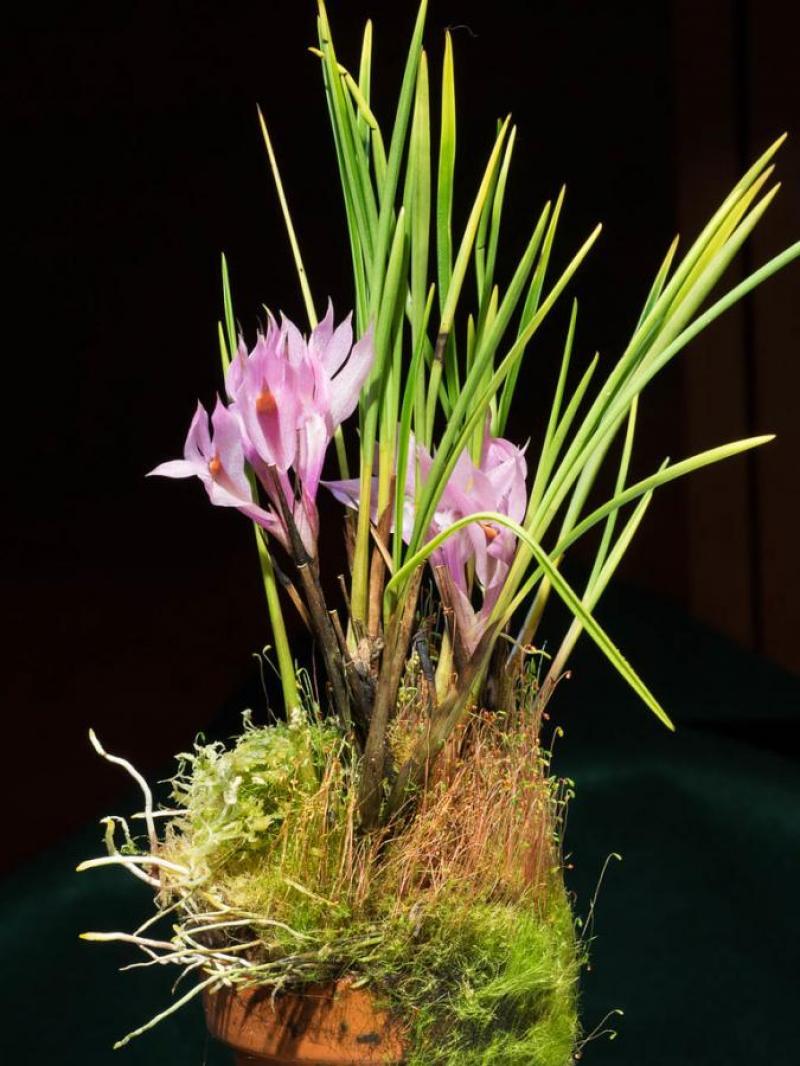Dendrobium violaceum
Also known as: The Purple Dendrobium or Pedilonum cyperifolium Pedilonum geminiflorum Pedilonum brachyacron Pedilonum dryadum Dendrobium violaceum h.f. violaceum Dendrobium violaceum h.v. cyperifolium Dendrobium cyperifolium Dendrobium pityphyllum Dendrobium allioides Dendrobium igneoviolaceum Dendrobium scotiiferum Dendrobium brachyacron Dendrobium geminiflorum Dendrobium tenuicalcar Dendrobium violaceum ssp. cyperifolium Dendrobium violaceum ssp. violaceum Dendrobium quinquecostatum Dendrobium dryadum Pedilonum pityphyllum Pedilonum quinquecostatum Pedilonum tenuicalcar Pedilonum scotiiferum in the subfamily: Epidendroideae
General Information
The Purple Dendrobium is a miniature sympodial cool to warm growing epiphytic, lithophytic or terrestrial orchid belonging to the sub family Epidendroideae.
Plant Description
Sympodial. Grows to 6-25cm. Each new growth has numerous leaves that grow to 13-18cm long. Pseudobulbs grow to 3-5cm
Substrate(s)
- Spaghnum Moss
Care Notes
These orchids live in environments that receive constant moisture, high humidity, and are surrounded by other plants such as ferns and mosses which not only attract moisture but compete for it as well.
As a consequence they can be difficult to keep healthy in an artificial environment where a constant balance has to be maintained between providing constant moisture to the roots, but also allowing them to not become soggy and dry quickly as they would in the wild. For this reason it's important to take into account the size of the plant, the health and fragility of the root system, and also think about your watering habits. If you water frequently you can use a media that drains more freely, if you water less reliably you will need to find a media that offers retention and keeps humidity around the roots without being soggy.
Because these orchids like high amounts of water, other plants such as ferns and weeds may start to grow alongside the orchid, whose roots can make the media quite dense, effectively strangling the orchid's roots, it's best to pluck them out before they become a problem. Fungus and bacteria can be an issue as well, but usually are a sign of overwatering, smell the media occasionally to check, and increase airflow, reduce watering, and adjust temperatures accordingly (often bacteria only flourish in warmer temperatures, fungus less so).
Climate
Grows at low to high elevations. Rainfall ranges from 119mm to 285mm per day, heaviest in September and lightest in December. Humidity ranges from 78% to 84%, highest in January and lowest in April. Temperature ranges from 12C to 24C, highest in May (14C to 24C) and lowest in December (12C to 22C).
Watering
These orchids prefer a constant supply of moisture, with a slight drying out between waterings. Saucers can be placed under pots to retain moisture during hot weather, however the saucers should be removed or let to dry every 1-2 weeks to prevent rot. Keep an eye on the plant especially in hot weather and look for cues of under/overwatering and adjust accordingly.
Keep moisture levels up during hot weather as the plant is prone to dehydrationFertiliser
Apply liquid based fertiliser per recommended directions. They can benefit from a high phosphate fertiliser leading up to flowering season, followed by a high nitrogen fertiliser when new growth appears, and a balanced fertiliser in other times. These orchids can also tolerate slow release fertiliser applied 1-2 pellets per cup (250ml) of media.
Use balanced fertiliser year round. Apply fertiliser regularly at half strength year round.Potting
These plants can be sensitive to repotting though should not require repotting regularly. Repotting should be done when the mix has broken down to the point that it doesn't absorb water or holds onto water for far too long, usually the plant shows a decline in growth as well.
The mix should be free draining, with a blend of 30% inorganic ingredients such as coarse sand, gravel or perlite, mixed in with about 70% organic ingredients such as peat, leaf litter or decomposed bark. Avoid commercial potting mixes as they can vary wildly and may contain "wetting agents" that can hold onto water for loo long, causing rotting and stunted growth.
This plant does well mounted.





















